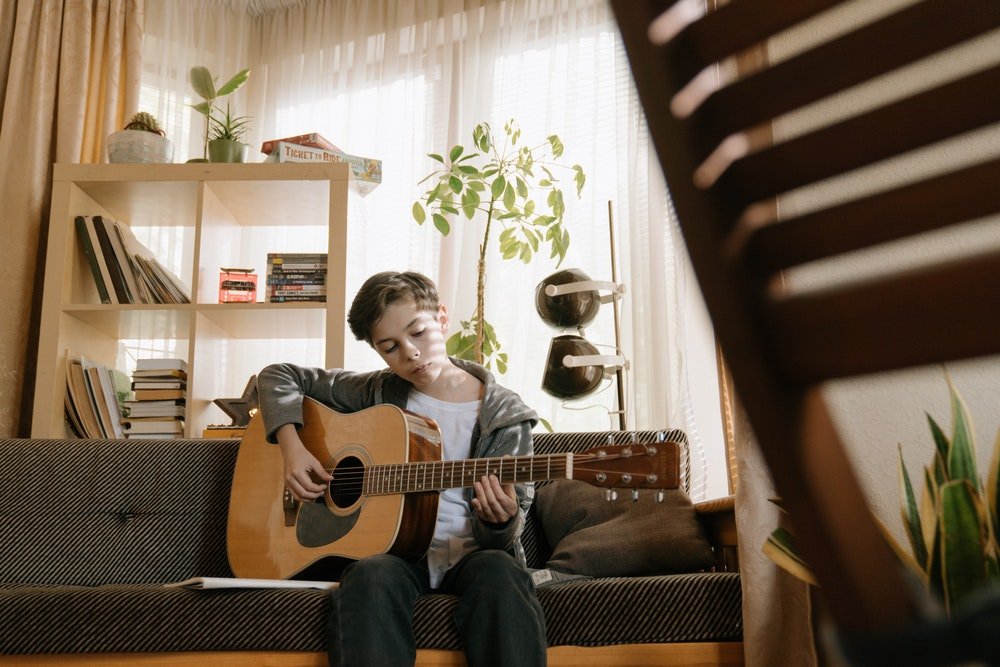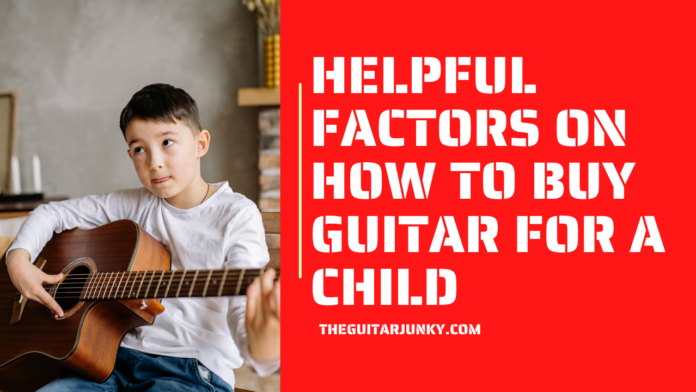The moment your kid starts to show interest in musical instruments (particularly, a guitar), you, as a parent, should not let it pass. It’s a parent’s responsibility to deliver and thinking about getting a guitar for your child should be running through your mind.
But, if it’s your first time to buy a guitar especially for kids, the safest thing to do first is to educate yourself. The factors on how to buy a guitar for a child is much like buying one for yourself, only a smaller version with less complicated features. And with this, I shall present to you 10 simple factors on how to buy guitar for a child.

Contents
Picking a Type
To help you narrow down your choices, think about which type your child might be more interested on. Generally, there are three different types of a guitar, namely, acoustic, classical, and electric. Each type has its own sound and design, which would be a great deciding factor for your kids.
An acoustic guitar is a steel-string guitar and is a great instrument to use for folk, pop, country, and slow rock music. With its design comes a bright and loud sound. Giving your child a guitar with steel strings might mean a hard time as steel strings aren’t exactly the gentle type.
Read: 9 Best Acoustic Guitars for Kids in 2021 (Reviews)
The second type is the classical guitar which is basically just an acoustic guitar having nylon strings. Classical guitars could be available in the smallest size making it the perfect size for children.
According to Artist Guitars, nylon-string guitars are really perfect for kids as they tend to be gentle on the fingers. Mostly used on genres like classical, flamenco, and Spanish music, classical guitars create mellow and soft sound that has just the right amount of volume.
Lastly, we have the electric guitars which are perfect for a child that’s into rock, metal, pop or country music. Typically the smallest among the three, electric guitars have steel strings.
Read: 10 Best Kids Electric Guitar in 2021
Age Does Matter, So Does Size
Aside from which type of guitar would be best for your child, it is important to pick one that’s age-appropriate so you’ll get the right size. With right size comes great playability and easy playing for your child. However, you must know that the size suggestions are approximate, and kids do grow at different rates.
According to First Guitar, at ages 4-6, you should get an acoustic guitar that has 30” or ¼ size. For kids aged up to 9 years old, you would have more options. With this age range, you can get an acoustic or classical guitar with 34” or ½ size, as well as a mini electric guitar.
At ages 9-12, acoustic ad classical guitars with 36” or ¾ size would be perfect. You can also choose a full size electric guitar, given that electric guitars are naturally small in size.
Some 12 year olds and above are comfortable with a concert size classical or dreadnought acoustic guitar. You can also choose a concert size acoustic or a full-size electric guitar.
Money Talks
Just like buying any other item, you need to think about the price. It would be a good idea not to invest in a top quality guitar just yet, since your child will grow out of the guitar or lose interest in the long run.
Thus, entry-level or beginner guitars should be the category for this. The important thing here is your child’s comfortability and the learning he/she will get out of the guitar.
Buying From The Big Brands
If you want to get the tried and tested models, then getting it from the big brands would be the fastest and easiest way. Manufacturers won’t be as known as they are today if not for their excellent models, be it entry-level or high-end.
You can also choose smaller companies since they tend to be more affordable. But, a lighter price might mean the quality could be compensated or cheaper materials are used.
Right Feel
Very importantly, only select a guitar you know is fully inspected and adjusted for easy playability, and has good-quality components. Most kids who stick with the learning process are encouraged to keep at it as they begin to create the sounds of the music they love and aspire to play better.
In order to do this, they need a guitar with decent sound and playability. Bring your kid with you at your local shop so he/she could test out his/her potential guitar.
Ask Lots of Questions
During your time at the local shop, it’s very necessary if you ask the sales associate to ask as many questions as you can. It’s their job to assist you on your purchase, might as well bombard them with your inquiries.
You could ask about the guitar’s intonation. An intonation refers to the instrument being in tune along the fretboard. This ensures if the guitar plays in tune as you move around the fretboard.
Another great question could be about the strings. Do they look like they’re in good condition?
Those are just examples of the questions you could ask. A good salesperson should know even a small information about the guitar you’re about to buy.
Set Up and Action
The guitar needs to be well set up, so it can be played easily and smoothly by your child. This means it needs to have the right action which is the measurement of how far the strings are from the fingerboard. If the action is too low, the strings will buzz a lot when you play. If it’s too high, then it will be very difficult to play anything.
Accessories
For beginners, it’s more convenient to have all the necessary accessories to play the guitar immediately. Such accessories include extra set of strings, a sturdy case, guitar strap, and a tuner. This applies to classical and acoustic guitars.
Electric guitars would also need the same set of paraphernalia, but would need an addition of an amplifier and its cable.
Your Child Has a Say, Too
Because it’s your child’s guitar, it’s only normal that he/she gives a say on which guitar to buy. You must also consider your child’s choices when it comes to picking a guitar so he/she won’t lose interest as time go by.
When picking the potential guitar for your kid, it’s important to relax, have fun, and not take the process too seriously. Make the guitar search a fun and memorable time for you and your child.
Opting For Second-hand
Second-hand guitars could expose you to decent models at a much lower price. However, used guitars would also mean old models with outdated features.
Buying a second-hand guitar as your child’s first guitar is an understandable choice, if you plan to upgrade and buy your child a better one in the future. Hey, as long as your child is happy, right?
